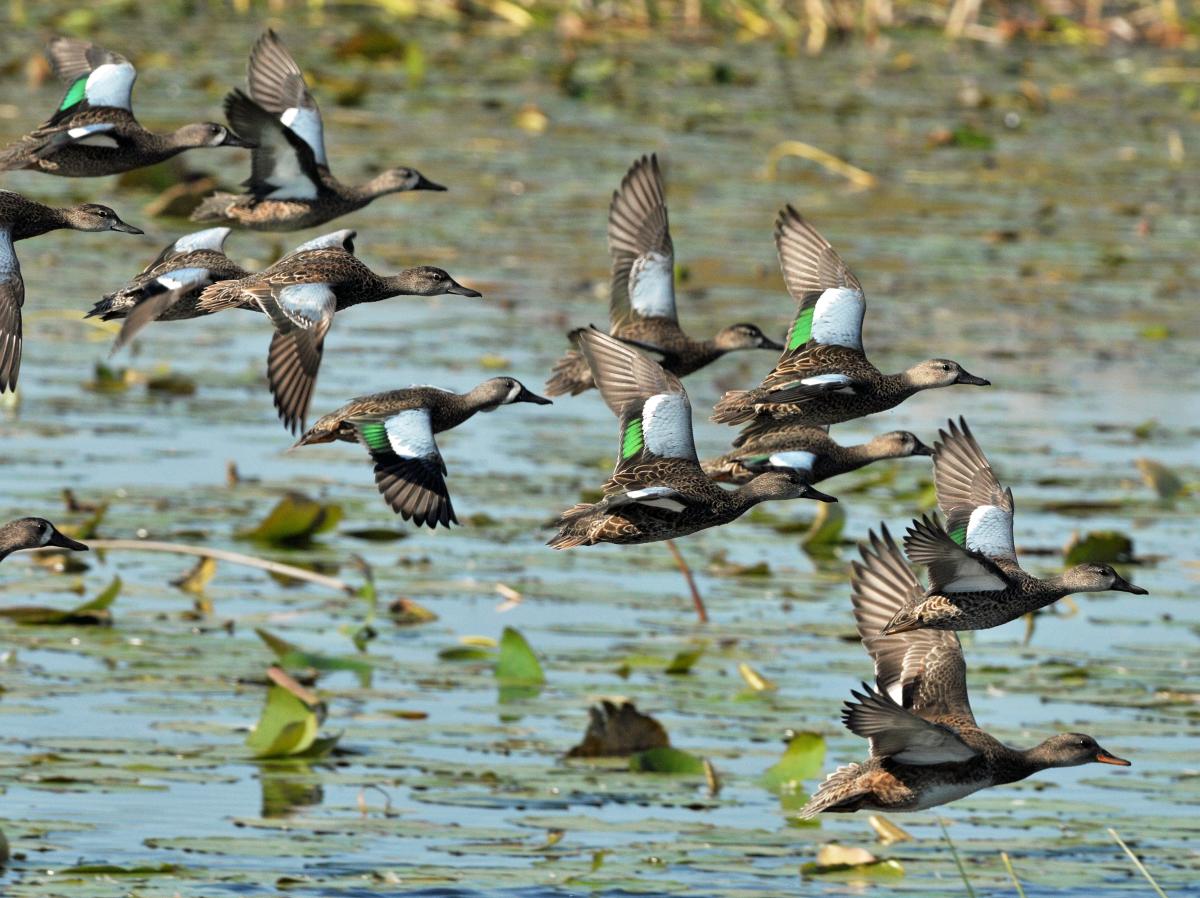Nestled quietly between St. Lawrence Park and Point Vivian a flock of gadwalls and bufflehead escape the typical bustle of the American Narrows. Countless lakers, landing crafts and pleasure boats pass under the Thousand Islands Bridge just a mile upstream.
Garlock Bay is the perfect hideaway whether you arrive by feather or fin. The restored coastal wetlands and thousands of feet of undeveloped shoreline here provide a rare year-round retreat and stronghold for the region’s wildlife, while also helping maintain the clean waters that many enjoy along the shore of the St. Lawrence River.
Though not officially labeled as Garlock Bay on navigation charts or USGS topo maps, the scenic embayment behind buoy “205” claims its name from decades of ownership and diligent stewardship by the Garlock family of Alexandria Bay. The late Richard Garlock, a renowned outdoorsman and local businessman, bequeathed this over 80-acre tract to his three daughters, Jennifer Garlock-Hebert, Marcia Slocum and Deirdre Beers in 2021. Plans to develop the shoreline have come and gone over the decades, but fortunately the land has been able to avoid that fate over the years.
With their shared vision for the land and love for the greater Thousand Islands, the Garlock sisters worked with TILT to ensure that Dick’s legacy of stewardship lives on. “Our Dad truly loved the River and this property,” reflected Jennifer Garlock. “It’s hard to describe how much this opportunity means to us. He’d be happy to know that it will stay forever wild, helping protect habitat for the fish and the ducks.”
The Land Trust purchased the property in April with assistance from the United State Fish and Wildlife Service’s (USFWS) Fish Enhancement, Mitigation and Restoration Fund (FEMRF) and New York State Department of Environmental Conservation’s (NYSDEC). One of the largest stretches of natural riverfront in mainland Jefferson County is now permanently protected.
Notably, Hebert, Slocum and Beers were recently contacted by United States Customs and Border Protection, which was interested in conducting bat surveys as part of its efforts to identify a site for the new Border Patrol operations facility. “While TILT and the River community recognize the importance of border security, we believe Custom & Border Protection (CBP) is able to advance its mission at the same time avoid negatively impacting our region’s most sensitive ecological areas,” stated Jake Tibbles, TILT’s Executive Director.
Restoration Investments
“Garlock Bay is a shallow aquatic ecosystem with submerged vegetation that provides critical spawning, rearing and foraging habitat for many fish species, including the muskellunge – or musky,” explained Ian Drew, Field Supervisor, USFWS. “Musky populations in the St. Lawrence River have experienced a significant and recent decline due to reduced spawning and nursery habitat; as well as losses attributed to a disease known as viral hemorrhagic septicemia (VHS). Maintenance of high-quality spawning and nursery habitat is critical to ensuring population recovery and sustainability.”
In 2012, Ducks Unlimited undertook an extensive wetland restoration project in the upper Garlock Bay complex. The restoration effort was funded by a USFWS Great Lakes Restoration Initiative (GLRI) grant administered through the National Oceanic and Atmospheric Administration. “The restoration work aimed to enhance the marsh ecosystem and fish spawning habitat,” described Sarah Fleming, DU Director of Conservation Programs. “The wetlands were opened up through the use of specialized long-front excavators, and channels and potholes were created in dense stands of cattail. Excavated material was either removed from the site or piled as habitat mounds that support native plants, such as sedges and rushes, providing great sources of food for waterfowl.” Additionally, a second wetland restoration project took place on the property’s interior as part of the St. Lawrence River Valley Phase I Standard NAWCA grant. This program provided for the expansion of a historic emergent wetland that had been partially ditched and drained decades ago. “There has been significant federal investment into the site, and transfer to TILT will ensure long term protection of the restored resources.”
Benefits Abound
When coupled with TILT’s permanent protection of the Garlock Property, the natural spaces in and around Point Vivian and Garlock Bay will serve as long-term spawning and nursery areas for fish that require marsh habitat, such as northern pike. The potholes will also create isolation areas for waterfowl broods and habitat for other marsh species such as Blanding’s turtles, Virginia rails, and least bittern.
In addition to the ecological benefits, by conserving parcels like the Garlock Property, TILT helps ensure a healthy balance between natural open space and responsible riverfront development. The Trust for Public Land’s economic study, peer reviewed by Clarkson University, concluded that preserves, trails, and conserved open spaces attract visitors to the region, enhance property values, provide recreational opportunities and boost responsible economic development.
For the scenic beauty enjoyed by those in St. Lawrence Park and Point Vivian, or the fishing guides targeting the toothy northern pike, and to all River-enthusiasts yet to come, the protection of the Garlock property is a high-impact conservation achievement worth celebrating.
Over the coming months, TILT intends to conduct a comprehensive natural resources inventory on the property. This will assist with the development of a long-term management plan which will guide the property’s use and care in the future.




